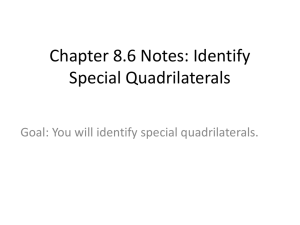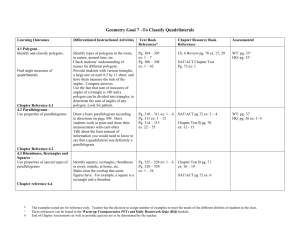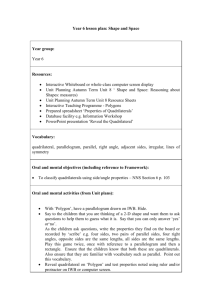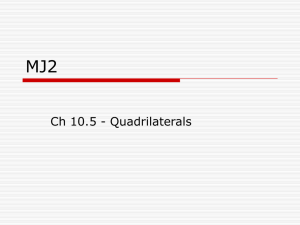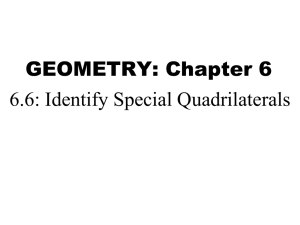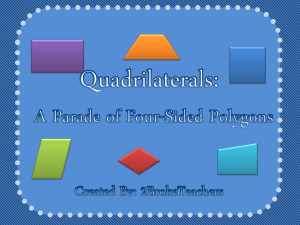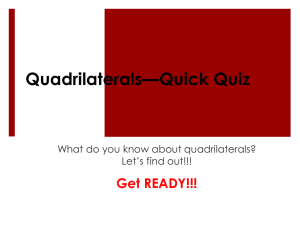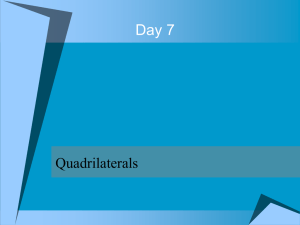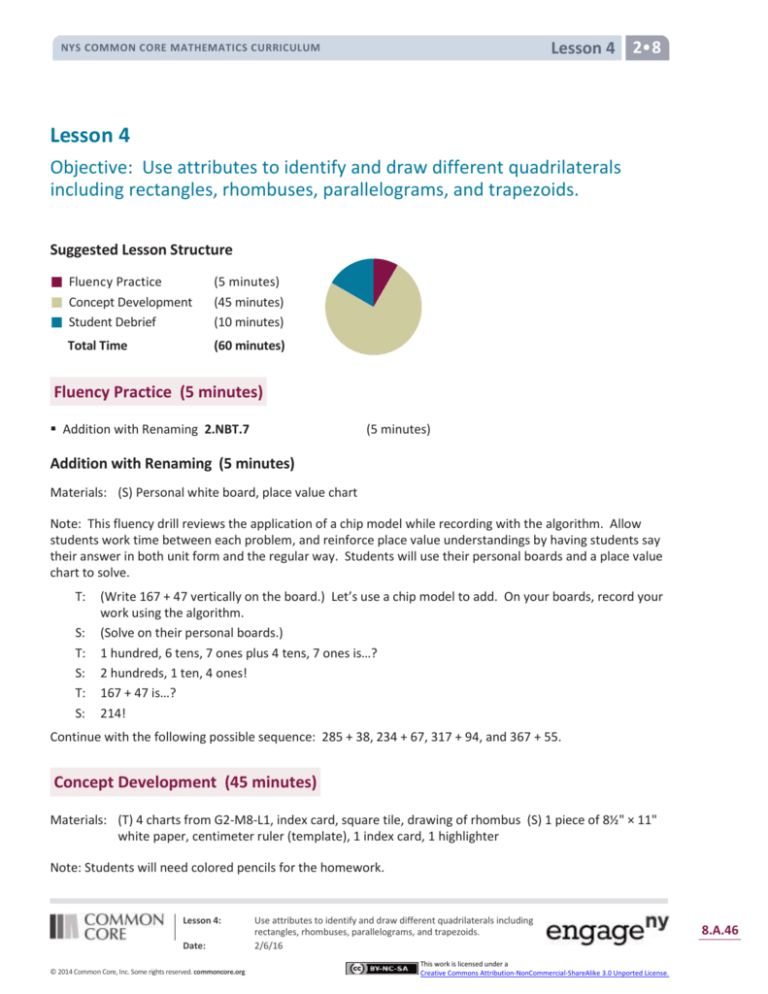
Lesson 4 2•8
NYS COMMON CORE MATHEMATICS CURRICULUM
Lesson 4
Objective: Use attributes to identify and draw different quadrilaterals
including rectangles, rhombuses, parallelograms, and trapezoids.
Suggested Lesson Structure
Fluency Practice
Concept Development
Student Debrief
Total Time
(5 minutes)
(45 minutes)
(10 minutes)
(60 minutes)
Fluency Practice (5 minutes)
Addition with Renaming 2.NBT.7
(5 minutes)
Addition with Renaming (5 minutes)
Materials: (S) Personal white board, place value chart
Note: This fluency drill reviews the application of a chip model while recording with the algorithm. Allow
students work time between each problem, and reinforce place value understandings by having students say
their answer in both unit form and the regular way. Students will use their personal boards and a place value
chart to solve.
T:
S:
T:
S:
T:
S:
(Write 167 + 47 vertically on the board.) Let’s use a chip model to add. On your boards, record your
work using the algorithm.
(Solve on their personal boards.)
1 hundred, 6 tens, 7 ones plus 4 tens, 7 ones is…?
2 hundreds, 1 ten, 4 ones!
167 + 47 is…?
214!
Continue with the following possible sequence: 285 + 38, 234 + 67, 317 + 94, and 367 + 55.
Concept Development (45 minutes)
Materials: (T) 4 charts from G2-M8-L1, index card, square tile, drawing of rhombus (S) 1 piece of 8½" × 11"
white paper, centimeter ruler (template), 1 index card, 1 highlighter
Note: Students will need colored pencils for the homework.
Lesson 4:
Date:
© 2014 Common Core, Inc. Some rights reserved. commoncore.org
Use attributes to identify and draw different quadrilaterals including
rectangles, rhombuses, parallelograms, and trapezoids.
2/6/16
This work is licensed under a
Creative Commons Attribution-NonCommercial-ShareAlike 3.0 Unported License.
8.A.46
Lesson 4 2•8
NYS COMMON CORE MATHEMATICS CURRICULUM
Note: Today’s Application Problem has been omitted due to the time intensive nature of the Concept
Development.
Note: The shape descriptions provided here provide a solid foundation to the definitions that will be part of
the students’ experience in later grades. Students are not expected to memorize these, but rather to have an
experience drawing different quadrilaterals using the new attributes of square corners and parallel sides.
Quadrilateral: A quadrilateral has four straight sides and is closed.
Trapezoid: A trapezoid has at least one pair of parallel sides.
Parallelogram: A parallelogram has two pairs of parallel sides.
Rectangle: A rectangle has four square corners.
Square: A square is a special rectangle with sides that are all the same length.
Rhombus: A rhombus has four sides that are all the same length.
Distribute a piece of 8½" × 11" white paper, a centimeter ruler, and an index card to each
student. Instruct students to follow you as they fold their papers in half twice, such that
they have four sections on both sides of the paper for drawing. (See image on right.) For
precision, students should use a pencil so that they have the option to erase as they draw
the shapes.
Part 1: Drawing Square Corners and Parallel Lines
T:
S:
T:
T:
S:
T:
T:
S:
T:
T:
T:
Look at your index card. How many angles, does it have?
Four!
Yes. Let’s look at our chart with other shapes that
have four sides and four angles. (Circle the shape on
the chart with three acute angles, as shown.)
How are the angles, or corners, on your index card
different from those of this shape?
The ones on my index card are all the same. The
corners on my card are in the shape of an L. The
ones on the chart are big and small.
We call the angles on our index cards square corners.
Look at Chart 2 again. Student A, come up and circle a square corner.
(Uses a marker to identify and circle a square corner.)
Thumbs up if you agree. Hmm, let’s use our index card to check to see
if Student A found a square corner. (Put the corner of the index card in
the corner of the shape, and show students how to check by seeing if
the lines of the shape line up with the edges of the index card.)
Good job, Student A! This is a square corner. (Find and check other
square corners.)
Let’s use our index cards as a tool to help us draw a quadrilateral with
one square corner.
Lesson 4:
Date:
© 2014 Common Core, Inc. Some rights reserved. commoncore.org
Use attributes to identify and draw different quadrilaterals including
rectangles, rhombuses, parallelograms, and trapezoids.
2/6/16
This work is licensed under a
Creative Commons Attribution-NonCommercial-ShareAlike 3.0 Unported License.
8.A.47
Lesson 4 2•8
NYS COMMON CORE MATHEMATICS CURRICULUM
T:
In one of the sections on your paper, draw a square corner using your index card as a guide. Then,
use the straight edge of your card to draw two more lines to complete your quadrilateral.
As time permits, students might practice how to make other quadrilaterals.
T:
Place your centimeter ruler vertically in the next section on your paper. Use your centimeter ruler to
draw a straight line within the section.
S: (Draw a straight line using a pencil.)
T: Without moving your ruler, use the opposite edge to draw a second
straight line of any length. (See image at right.)
S: (Draw a second straight line parallel to the first one using a pencil.)
T: What do you notice about these lines?
S: One is shorter than the other one. They don’t touch.
They don’t make a corner or angle. They are the same
distance apart. The lines never come closer or get farther
away from each other. They look like the sides of an H.
T: If I used a really long ruler and a really long piece of
paper and kept drawing these lines, they would never
NOTES ON
cross or touch.
TRAPEZOIDS:
T: We call these parallel lines. (Write parallel on the
board.) Look at the word parallel. The two L’s in the
According to the K–6 Geometry
middle of the word are parallel.
Progressions, the term trapezoid may
have two different meanings,
T: In the next section, position your ruler in different
depending on an exclusive or inclusive
ways— horizontally, diagonally—and practice making
definition.
more pairs of parallel lines.
Exclusive: A trapezoid is a
S: (Practice making parallel lines with their rulers in
quadrilateral with exactly one pair
different positions.)
of parallel sides.
Inclusive: A trapezoid is a
As time permits, direct the students to Chart 2 again to answer
quadrilateral with at least one pair
the question, “Which of these shapes has a pair of parallel
of parallel sides.
lines?”
Part 2: Drawing and Identifying a Trapezoid
T:
S:
T:
MP.6
S:
T:
S:
T:
Position your ruler horizontally in a new section on
your paper. Use your ruler to draw a straight line that
is 8 cm long.
(Draw an 8-cm line using a pencil.)
Without moving your ruler, use the opposite edge of the ruler
to draw a second straight line. Then, with your ruler, join the
ends of both lines. (See three examples shown on the right.)
(Use rulers to join the ends of both lines, forming a trapezoid.)
You made a four-sided polygon. What do we call it?
A quadrilateral!
Compare your quadrilateral with those of your neighbors.
Lesson 4:
Date:
© 2014 Common Core, Inc. Some rights reserved. commoncore.org
While both definitions are legitimate,
this curriculum uses the inclusive
definition. Therefore, a parallelogram
is also considered a trapezoid.
Use attributes to identify and draw different quadrilaterals including
rectangles, rhombuses, parallelograms, and trapezoids.
2/6/16
This work is licensed under a
Creative Commons Attribution-NonCommercial-ShareAlike 3.0 Unported License.
8.A.48
Lesson 4 2•8
NYS COMMON CORE MATHEMATICS CURRICULUM
T:
S:
MP.6
T:
S:
T:
S:
T:
S:
Turn and talk: What new attribute do you notice about the sides of these quadrilaterals?
They all have parallel sides. Two opposite sides are parallel, but on some of our shapes, the other
two aren’t. The opposite sides are different lengths (or the same length, depending on the
figure). They all have a pair of parallel sides.
Does this quadrilateral have at least one pair of parallel sides?
Yes!
(Point to a different trapezoid, which may be a parallelogram or rectangle.) How about this
quadrilateral?
Yes!
Your quadrilaterals are trapezoids if they have at least
NOTES ON
one pair of parallel sides. What is our new word?
MULTIPLE MEANS OF
ENGAGEMENT:
Trapezoid!
Part 3: Drawing and Identifying a Parallelogram
T:
S:
T:
S:
T:
S:
T:
S:
T:
S:
Some students might have difficulty
drawing the different shapes. Support
their learning by providing them with a
template for their individual boards
that has some of the lines already
drawn, so that all they have to do is
extend their drawings to connect the
sides. This is especially useful for
creating the trapezoid. Students may
also be offered the use of a geoboard.
Turn your paper over. In another section, use both
sides of your ruler to draw two parallel lines that are
each 8 cm long. Draw one line starting at zero and
stopping at 8 cm. Draw the other starting at any
number but advancing 8 centimeters, like this.
(Demonstrate.) Now, it’s your turn.
(Draw two parallel lines, each 8 cm in length.)
Use these parallel lines to make another quadrilateral
by joining the ends of the parallel sides.
(Use their rulers to join the ends of both lines, forming a
parallelogram, as shown on right.)
What do you notice about the connecting sides?
They are also parallel.
How can you be sure?
They look like they won’t touch if they keep going. I can put my
ruler down that way and see the other line runs along it without
getting any closer.
Since this quadrilateral has two pairs of parallel sides (point to the parallel sides), we call it a
parallelogram. What’s it called?
A parallelogram!
Part 4: Drawing and Identifying a Rectangle and Square and Relating the Rhombus to a Square
T:
S:
T:
Now, let’s draw another quadrilateral. In another section on your paper, use both sides of your ruler
to draw two parallel lines that are 8 cm long. This time, start both lines at zero on your ruler.
(Measure and draw two parallel lines, each beginning at zero and extending 8 cm in length.)
Complete the quadrilateral by drawing two more lines.
Lesson 4:
Date:
© 2014 Common Core, Inc. Some rights reserved. commoncore.org
Use attributes to identify and draw different quadrilaterals including
rectangles, rhombuses, parallelograms, and trapezoids.
2/6/16
This work is licensed under a
Creative Commons Attribution-NonCommercial-ShareAlike 3.0 Unported License.
8.A.49
Lesson 4 2•8
NYS COMMON CORE MATHEMATICS CURRICULUM
S:
T:
S:
T:
S:
T:
T:
S:
T:
T:
S:
T:
S:
T:
T:
S:
T:
T:
(Use their rulers to join the ends of both lines, forming a rectangle,
as shown on right.)
Turn and talk: What do you notice about the angles of this special
quadrilateral?
They make square corners!
You already know this shape. What is it?
A rectangle!
Yes! A quadrilateral with four square corners is a rectangle.
There is a special rectangle, too. It is special because it
NOTES ON
has four square corners and four sides that are the
MULTIPLE MEANS OF
same length. What do you think it is?
ACTION AND
A square!
EXPRESSION:
Watch as I draw a square. (Draw a square on the
Find time to help English language
board.)
learners practice producing new
Let’s double check to see if it is a rectangle. Student D,
geometric vocabulary. The sooner
use your index card to check the corner angles to see if
students are able to use the new
they are square corners.
vocabulary, the quicker they will learn
it and use it. Make a game of it. Show
(Student D checks corners.) Yes! They are square
students the shape and ask them to
corners.
say its name, or ask them match
Good. Finally let’s check to see if the sides are all the
shapes with their name and say the
same length. Student E, use your ruler to measure
name as they do.
each side of the square.
(Student E measures sides.) All the sides are 10 cm! It is a square.
Just like a square, there is another quadrilateral that has four equal sides. It
looks like this. (Draw a rhombus on the board.)
What do you notice?
It looks like a square leaning over. I don’t think it has square corners. I
think the sides are all equal, like a square. I see that both pairs of opposite
sides are parallel.
Yes! We call a quadrilateral with four equal sides a rhombus. It does have equal sides like a square,
but it doesn’t have to have square corners.
You’ve really flexed your geometry muscles today! On to the Problem Set!
Problem Set (10 minutes)
Students should do their personal best to complete the Problem Set within the allotted 10 minutes. For some
classes, it may be appropriate to modify the assignment by specifying which problems they work on first.
Some problems do not specify a method for solving. Students solve these problems using the RDW approach
used for Application Problems.
Note: It is possible that there will not be enough time today for the Problem Set! If just a few minutes
remain, consider having students instead draw different quadrilaterals with the attributes of parallel lines and
square corners and see if they can identify which names apply to their shapes.
Lesson 4:
Date:
© 2014 Common Core, Inc. Some rights reserved. commoncore.org
Use attributes to identify and draw different quadrilaterals including
rectangles, rhombuses, parallelograms, and trapezoids.
2/6/16
This work is licensed under a
Creative Commons Attribution-NonCommercial-ShareAlike 3.0 Unported License.
8.A.50
Lesson 4 2•8
NYS COMMON CORE MATHEMATICS CURRICULUM
Student Debrief (10 minutes)
Lesson Objective: Use attributes to identify and draw
different quadrilaterals including rectangles,
rhombuses, parallelograms, and trapezoids.
The Student Debrief is intended to invite reflection and
active processing of the total lesson experience.
Invite students to review their solutions for the Problem
Set. They should check work by comparing answers
with a partner before going over answers as a class.
Look for misconceptions or misunderstandings that can
be addressed in the Debrief. Guide students in a
conversation to debrief the Problem Set and process
the lesson.
You may choose to use any combination of the
questions below to lead the discussion.
Turn and talk: What do you know about
parallel lines? Where do you see some in our
classroom?
Can a shape have different names? Tell your
partner other names that a quadrilateral can
be called.
Use your fingers to show your partner a square
corner. Use your fingers to show your partner
an angle that is not square.
What did all the shapes we talked about today
have in common? (They all were
quadrilaterals, or four-sided polygons, with
four sides, corners, or angles.)
Use some of the new vocabulary words you
learned today to describe to your partner the
attributes of a rectangle? A trapezoid? A
parallelogram? A square? A rhombus?
What makes a square a special rectangle?
Explain how you know.
Exit Ticket (3 minutes)
After the Student Debrief, instruct students to complete the Exit Ticket. A review of their work will help you
assess the students’ understanding of the concepts that were presented in the lesson today and plan more
effectively for future lessons. You may read the questions aloud to the students.
Lesson 4:
Date:
© 2014 Common Core, Inc. Some rights reserved. commoncore.org
Use attributes to identify and draw different quadrilaterals including
rectangles, rhombuses, parallelograms, and trapezoids.
2/6/16
This work is licensed under a
Creative Commons Attribution-NonCommercial-ShareAlike 3.0 Unported License.
8.A.51
Lesson 4 Problem Set 2•8
NYS COMMON CORE MATHEMATICS CURRICULUM
Name
Date
1. Use your ruler to draw 2 parallel lines that are not the same length.
2. Use your ruler to draw 2 parallel lines that are the same length.
3. Highlight the parallel sides on each quadrilateral, and put a box around each right
angle. Use your index card to find each right angle.
a.
b.
c.
d.
e.
f.
g.
h.
4. Draw a parallelogram with no square corners.
Lesson 4:
Date:
© 2014 Common Core, Inc. Some rights reserved. commoncore.org
Use attributes to identify and draw different quadrilaterals including
rectangles, rhombuses, parallelograms, and trapezoids.
2/6/16
This work is licensed under a
Creative Commons Attribution-NonCommercial-ShareAlike 3.0 Unported License.
8.A.52
NYS COMMON CORE MATHEMATICS CURRICULUM
Lesson 4 Problem Set 2•8
5. Draw a quadrilateral with 4 square corners.
6. Measure and label the sides of the figure to the right with
your centimeter ruler. What do you notice? Be ready to talk
about the attributes of this quadrilateral. Can you remember
what this polygon is called?
7. A square is a special rectangle. What makes it special?
_________________________________________________________________
_________________________________________________________________
Lesson 4:
Date:
© 2014 Common Core, Inc. Some rights reserved. commoncore.org
Use attributes to identify and draw different quadrilaterals including
rectangles, rhombuses, parallelograms, and trapezoids.
2/6/16
This work is licensed under a
Creative Commons Attribution-NonCommercial-ShareAlike 3.0 Unported License.
8.A.53
Lesson 4 Exit Ticket 2•8
NYS COMMON CORE MATHEMATICS CURRICULUM
Name
Date
1. Highlight the parallel sides on each quadrilateral, and put a box around each square
corner. Use your index card to find each square corner.
a.
b.
Lesson 4:
Date:
© 2014 Common Core, Inc. Some rights reserved. commoncore.org
c.
d.
Use attributes to identify and draw different quadrilaterals including
rectangles, rhombuses, parallelograms, and trapezoids.
2/6/16
This work is licensed under a
Creative Commons Attribution-NonCommercial-ShareAlike 3.0 Unported License.
8.A.54
NYS COMMON CORE MATHEMATICS CURRICULUM
Name
Lesson 4 Homework 2•8
Date
1. Use your ruler to draw 2 parallel lines that are not the same length.
2. Use your ruler to draw 2 parallel lines that are the same length.
3. Draw a quadrilateral with two sets of parallel sides. What is the name of this
quadrilateral?
4. Draw a quadrilateral with 4 square corners and opposite sides the same length.
What is the name of this quadrilateral?
Lesson 4:
Date:
© 2014 Common Core, Inc. Some rights reserved. commoncore.org
Use attributes to identify and draw different quadrilaterals including
rectangles, rhombuses, parallelograms, and trapezoids.
2/6/16
This work is licensed under a
Creative Commons Attribution-NonCommercial-ShareAlike 3.0 Unported License.
8.A.55
Lesson 4 Homework 2•8
NYS COMMON CORE MATHEMATICS CURRICULUM
5. A square is a special rectangle. What makes it special?
_________________________________________________________________
_________________________________________________________________
6. Color each quadrilateral with 4 square corners red.
Color each quadrilateral with no square corners blue.
Color each quadrilateral with one set of parallel sides green.
Lesson 4:
Date:
© 2014 Common Core, Inc. Some rights reserved. commoncore.org
Use attributes to identify and draw different quadrilaterals including
rectangles, rhombuses, parallelograms, and trapezoids.
2/6/16
This work is licensed under a
Creative Commons Attribution-NonCommercial-ShareAlike 3.0 Unported License.
8.A.56
Lesson 4 Template 2•8
NYS COMMON CORE MATHEMATICS CURRICULUM
Copy onto heavy tag board and cut.
1
2
3
4
5
6
7
8
9
10
11
12
13
14
15
2
3
4
5
6
7
8
9
10
11
12
13
14
15
2
3
4
5
6
7
8
9
10
11
12
13
14
15
2
3
4
5
6
7
8
9
10
11
12
13
14
15
2
3
4
5
6
7
8
9
10
11
12
13
14
15
2
3
4
5
6
7
8
9
10
11
12
13
14
15
2
3
4
5
6
7
8
9
10
11
12
13
14
15
2
3
4
5
6
7
8
9
10
11
12
13
14
15
cm
c
1
cm
1
cm
1
cm
1
cm
1
cm
1
cm
1
cm
Lesson 4:
Date:
© 2014 Common Core, Inc. Some rights reserved. commoncore.org
Use attributes to identify and draw different quadrilaterals including
rectangles, rhombuses, parallelograms, and trapezoids.
2/6/16
This work is licensed under a
Creative Commons Attribution-NonCommercial-ShareAlike 3.0 Unported License.
8.A.57

